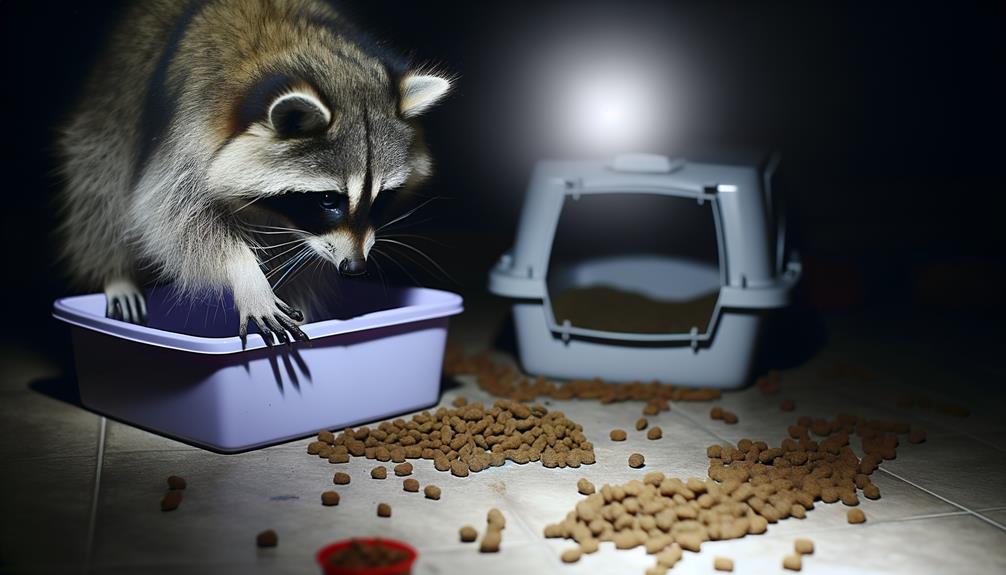How to Keep Raccoons from Being Attracted to Cat Litter
Yes, raccoons are attracted to cat litter. They are opportunistic feeders, and the strong smell emanating from cat litter can lure them.
Cat feces in the litter, despite sounding unappetizing, can be seen as an accessible food source thanks to their omnivorous diet. The attraction is more due to their adaptability and survival instinct rather than a specific nutritional need.
However, their attraction to cat litter carries risks like transmission of diseases like rabies and toxoplasmosis. For responsible prevention and control, a need arises to understand raccoon behavior and the potential hazards their attraction to cat litter presents.

Key Takeaways
- Raccoons are attracted to cat litter due to its strong odor and easy accessibility.
- Cat excrement contains dietary components appealing to these opportunistic feeders.
- This attraction is driven by survival instinct and adaptability, not biological needs.
- Raccoons risk contracting diseases such as Toxoplasmosis from consuming cat litter.
- To deter raccoons, properly dispose cat litter and secure potential entry points.
Understanding Raccoon Behavior
To understand why raccoons might be drawn to cat litter, it is essential to first explore an understanding of the behavioral patterns inherent to these nocturnal mammals. Raccoons, scientifically known as Procyon lotor, are omnivorous creatures with a highly adaptable feeding behavior. They are opportunistic feeders, consuming an array of foods including fruits, plants, insects, and small animals.
However, their diet preference shifts towards easily accessible and high-calorie foods when available. Raccoons are also noted for their remarkable problem-solving abilities and dexterity, enabling them to exploit human resources effectively. This behavior, coupled with their natural curiosity, may lead them to explore unusual food sources.
Understanding these behavioral tendencies can provide critical insight into the possible attraction raccoons might have towards cat litter.
The Attraction: Raccoons and Cat Litter
Drawing from their behavioral tendencies, raccoons can indeed be attracted to cat litter, as it represents an easily accessible and unconventional food source. Their opportunistic and omnivorous nature allows them to find sustenance in unlikely places, including the remnants of feline waste.
The strong odors emitted from cat litter, primarily from the urine and feces, can lure these creatures from a considerable distance. Additionally, the dietary components found in cat excrement, such as undigested proteins and fats, can be appealing to raccoons.
It is essential to understand this attraction is not driven by any biological or physiological need, but rather by the raccoon's inherent adaptability and survival instinct, which compels them to exploit any available resources.
Potential Risks and Dangers
Often overlooked, the interaction between raccoons and cat litter not only presents a significant nuisance for homeowners but also harbors potential health risks and hazards for both the raccoons and domestic pets.
Raccoons rummaging through cat litter can contract Toxoplasmosis, a disease that can lead to serious neurological issues. Similarly, pets are at risk of acquiring infectious diseases and parasites from raccoons, including Rabies and Roundworm. The latter can be fatal if left untreated.
Additionally, raccoons can inadvertently spread bacteria and parasites in the environment, increasing the risk of infection for humans, especially children. Essentially, the raccoon-cat litter interaction is more than a mere inconvenience; it is a public health concern that must be addressed.
Preventative Measures Against Raccoons
In addressing the issue of raccoons' attraction to cat litter, it becomes crucial to implement strategic and effective preventative measures to mitigate the potential health risks and environmental hazards. Initial steps involve understanding the behavioral patterns of raccoons, including feeding habits and nocturnal activities, to determine the best timing for securing possible entry points.
Scientifically, applying deterrents such as commercial repellents could disrupt their sense of smell, reducing their attraction to cat litter.
Another significant preventative measure to take into account is the proper and regular disposal of cat litter, ensuring it's less accessible for raccoons.
In essence, implementing these measures creates a symbiotic relationship between human freedom and wildlife preservation, ensuring co-existence without infringing on the liberty of either party.
Solutions for a Raccoon-Free Home
To guarantee a raccoon-free home, adopting an all-encompassing and scientifically proven strategy becomes necessary, encompassing both indoor and outdoor practices that range from meticulous waste management to the deployment of advanced anti-raccoon devices.
The implementation of a robust waste management system is essential, as raccoons are attracted to food remnants. Sealed compost bins and trash cans will deter these creatures.
Anti-raccoon devices offer a high-tech solution. Ultrasonic repellents emit frequencies unpalatable to raccoons, while motion-activated sprinklers provide an unwelcome surprise.
For indoor protection, securing potential entry points is important. Reinforced screens, chimney caps, and sealing gaps can dissuade trespassing. Cat litter should be kept inaccessible, as its scent can lure raccoons.
Implementing these practices can secure a raccoon-free environment.
Conclusion
To sum up, the allure of raccoons to cat litter is a fascinating interplay of ecological interaction and urban encroachment.
The potential risks and resulting preventive measures emphasize the significance of well-informed management strategies.
Putting into action efficient remedies, like secured trash receptacles and pet waste disposal methods, are essential in cultivating a raccoon-free environment.
Therefore, a thorough understanding of raccoon behavior is crucial in establishing a harmonious balance between human spaces and wildlife habitats.






